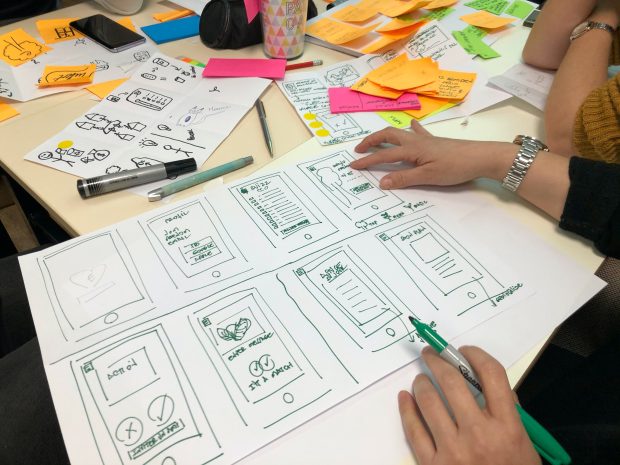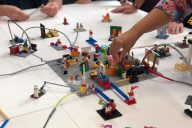Author is a design thinking enthusiast and a service designer, who has designed, organised or taken part in three different types of innovation events: Hackathons, Service Jams, and Design Sprints. These topics are covered in the subsequent parts of this series, they can be read in any order. Find the introduction post, the first part Service Jams and the second part Hackathons on Tikissä.
So, you may have wondered “what is the difference between a Hackathon, a Jam, and a Design Sprint?” These words swirl around with an assumption that people know what they are and what the difference is. All three of these events are what I would call innovative learning by doing events. They all require a new way of thinking and working and they will all have the participants learning at an intense rate.
I am currently in the process of becoming a Design Sprint Master (their term, definitely not my choice) and I truly believe in this process as a design professional. In reality, not everyone has weeks or months to spend on research prior to development. With this in mind, let’s look at what DESIGN SPRINTS as an intensive learning by doing events can offer to participants.
5+ Days to Solution
A Design Sprint is a methodology that was developed at Google and is a 5-day intensive event that is for the purpose of solving one defined, critical business problem. Their own website describes it as “… a proven methodology for solving problems through designing, prototyping, and testing ideas with users.”(1) These are, for the most part, used in workplaces and universities (to teach the methodology). They can also be extended if the participants need to continue doing other work but generally, it isn’t so useful to shrink them.
Design Sprints are the longest of these three events taking 5 days. Over the 5 days, you are moved through a very specific process each day. These events are primarily used in two ways: in-house events focused on development or problem-solving or in educational institutions (where the timeline may be expanded to 10 days or more to allow for teaching and learning along the way).
The concept of a Design Sprint was developed at Google Ventures (now just GV) (2) in the early 2010s. It seems that it was an organic change in work practice to see if they could get feedback on ideas/prototypes/beta versions of products/services out more quickly but also to cut pointless meetings off at the knees. Basically, from where I sit, it is to decrease the talking and increase the doing. The go-to book on this is Sprint by Jake Knapp, John Zeratsky, and Braden Kowitz. (3)
How Design Sprints work?
A Design Sprint is an intense 5-day process with a facilitator guiding the process. In a company Design Sprint, everyone is working on the same problem and only the people that need to be there are there. This is not an open process. This process requires the participants to clear their schedules for a full week in order to fully participate and not be distracted.
The process follows the same 5 steps in a creative but controlled environment.
- step (Monday): making a map & choosing a target
- step (Tuesday): sketch competing solutions
- step (Wednesday): decide on the best with a testable hypothesis
- step (Thursday): build a realistic prototype
- step (Friday): test with real target customers.
This is a process to allow a small group to make rapid progress in just 5 days. The process is similar in an educational setting, but in order to fully grasp the different elements and to analyse them from a learning perspective, these sprints are usually (sometimes), expanded as students aren’t always able to clear their schedule or have a fixed team that they always work with. This adds different dimensions to the process.
What are the outcomes?
The outcomes are very tangible. Your team will expand their entrepreneurial mindset, they will learn how to use innovative methods, they will learn the value of rapid prototyping in business/service/product development, and they will learn how to take these methods forward to use in the future and in other parts of their work and life. That tangible outcome mentioned above: a tested concept with real customer/user feedback.
How teams are created?
In companies, teams are chosen for the skills that are needed to take the process forward. One imperative is that there always needs to be a ‘Decider’, a real person who has the authority and the budget to make decisions to allow the group to move forward. Without this, the process is potentially a dud. Without a decision-maker, everything is guessing.
In an educational setting, the teams are set by who and how many join the course. But it is still understood that diversity in skillset and experience is good to have. So many times, teams are not self-forming.
What skills are needed?
If this Design Sprint is taking place within a company, there will be a pre-defined problem that will be being solved. This means that specific skills and product/service knowledge are important to identify within the team that will be formed. As mentioned above, when it comes to an educational setting, it is maybe more important to come with an open mind. It is a learning process and some new skills will be taught along the way.
What makes the best Design Sprint teams?
The best teams for a Design Sprint are ones that don’t try to jump straight to solutions, who come with an open mind and a willingness to learn and try new things. A great team will also allow for everyone to have their voice heard and feel valued. It will also achieve a great outcome when everyone who was part of the team feels that they are part-owner of the outcome.
What connections are made?
Depending on the size of the organization, you may be able to connect with people from other parts of the organisation that you rarely or never work with. It can also be easier to connect with people who have been through a Design Sprint before (even one you didn’t attend) because of the shared experience. Seeking like-minded people may become important to you in your work.
At an educational institution, you will meet new people and connect with other people interested in this type of development process. You will also probably continue to look for more of these kinds of experiences or even for companies who embrace this kind of thinking. So, this kind of experience can inspire you to attend events that you maybe wouldn’t have before.
Where would you find a Design Sprint?
Design Sprints are a great basis for a course. This is already used at Metropolia in the 10 Days 100 Challenges course that runs each May/June in collaboration with Laurea and Haaga-Helia in 3AMK. The 10 Days 100 Challenges is a 10-day design sprint with real businesses and real business challenges that earns students either 5 ECTS or 10 ECTS. This type of course is also used at Laurea also. So, there are very accessible educational use cases that you can investigate.
Author
Pamela Spokes works as a Service Designer in Metropolia’s RDI team. Originally from Canada, Pamela has years of experience in university admin focusing on international recruitment, marketing, and the international student/staff experience. With a Bachelor’s from Canada, a Master’s degree from Sweden, an MBA in Service Innovation & Design from Laurea, and her AmO from Haaga-Helia, she is interested in purposefully designed experiences that are centred around the user. Don’t be surprised if she knocks on your door to talk about learning co-creation methods through intensive learning experiences.
Sources
- Design Sprint Kit with Google
- Google Ventures/GV
- Knapp, J., Zeratsky, J., & Kowitz, B. (2016). Sprint. Bantam Press









Ei kommentteja